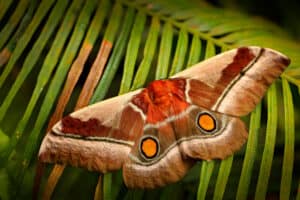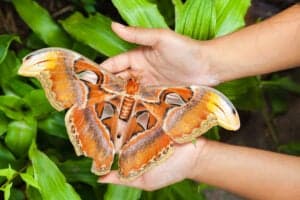The largest state in the lower 48 states, Texas is home to plenty of amazing scenery and wildlife. Moths are a common type of insect you’ll find in this state. There are countless different species of moth fluttering around the state of Texas, making them one of the most diverse groups in the region. If you are looking to identify some of these nocturnal creatures, you have come to the right place! In this article, we will go over 15 of the most common moths in Texas. Ready to learn? Let’s get straight to it!
1. Hummingbird Clearwing (Hemaris thysbe)
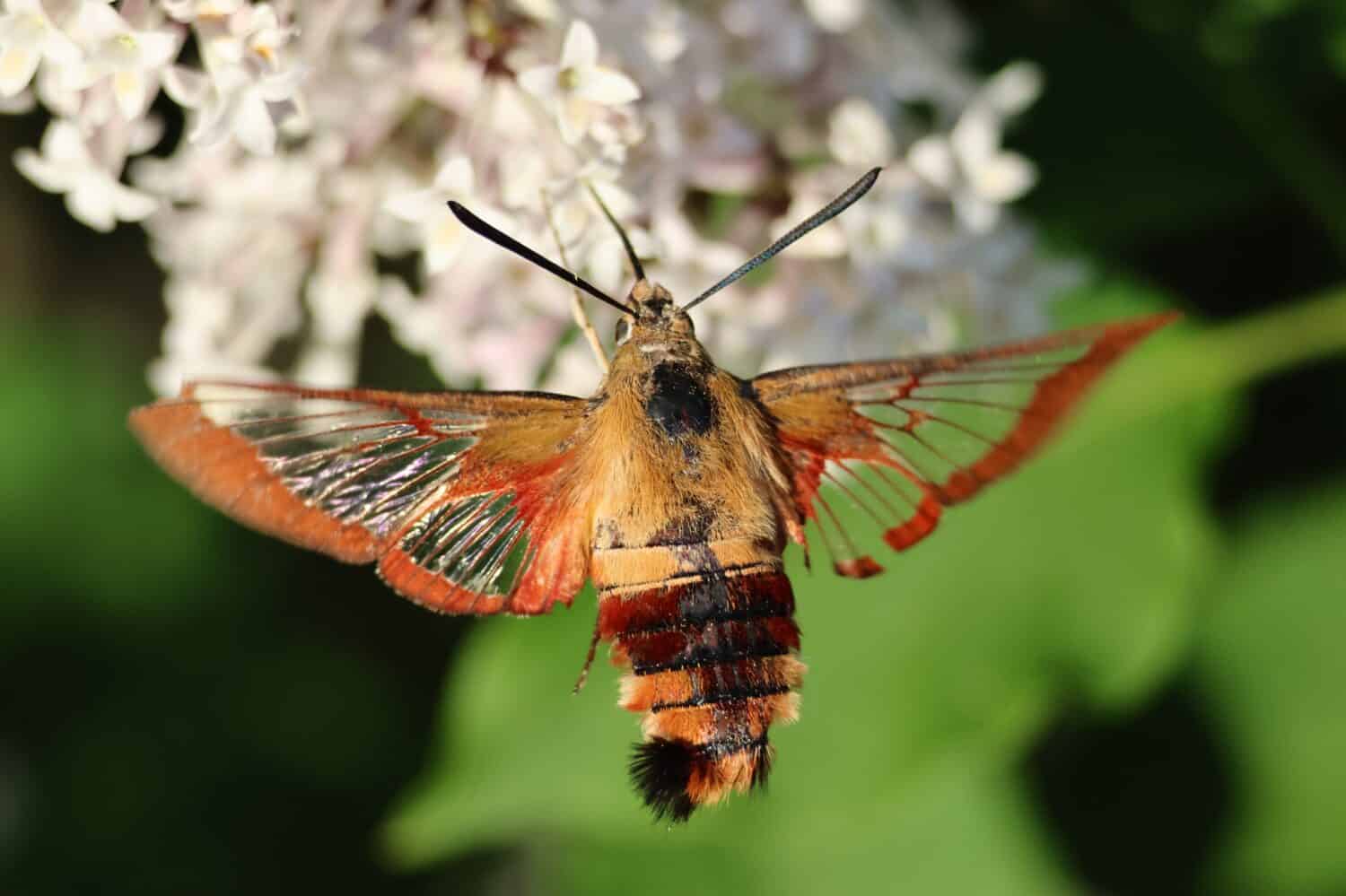
The
hummingbird
clearwing is named due to its hummingbird bird-like flight.
©Sam Hanrahan/Shutterstock.com
| Feature | Description |
|---|---|
| Size | Wingspan: 1.5 to 2 inches |
| Appearance | Olive green and burgundy back, white or yellow and burgundy underside, transparent wings with reddish-brown border. |
| Notable Features | Resemble a hummingbird in size and flight, furry greenish-yellow or tan body with a reddish-brown band across the abdomen. |
The hummingbird clearwing moth (Hemaris thysbe) is a fascinating day-flying moth. This species is commonly found in North America’s open areas like sunny parks, breezy woodlands, and gardens. These moths, with their rapidly beating wings, appear in the warm spring and are most active during the hot summer. Eagerly, they sip nectar from colorful flowers like bright Red Clover and fragrant Phloxes using their long, retractable proboscis — handily tucked beneath their heads when resting.
The green, munching larvae, however, prefer specific plants — mostly dogbane and cherry trees. Female hummingbird clearwings lay their eggs on these plants, and once hatched, the caterpillars feed ravenously. After their hearty meals, they build a protective cocoon on the ground, usually hidden by fallen leaves, and there — they wait. They stay through the cold winter and emerge vibrantly in spring. In colder areas, you’ll see them once a year, but in warmer ones, they might surprise you more often.
2. Giant Leopard Moth (Hypercompe scribonia)
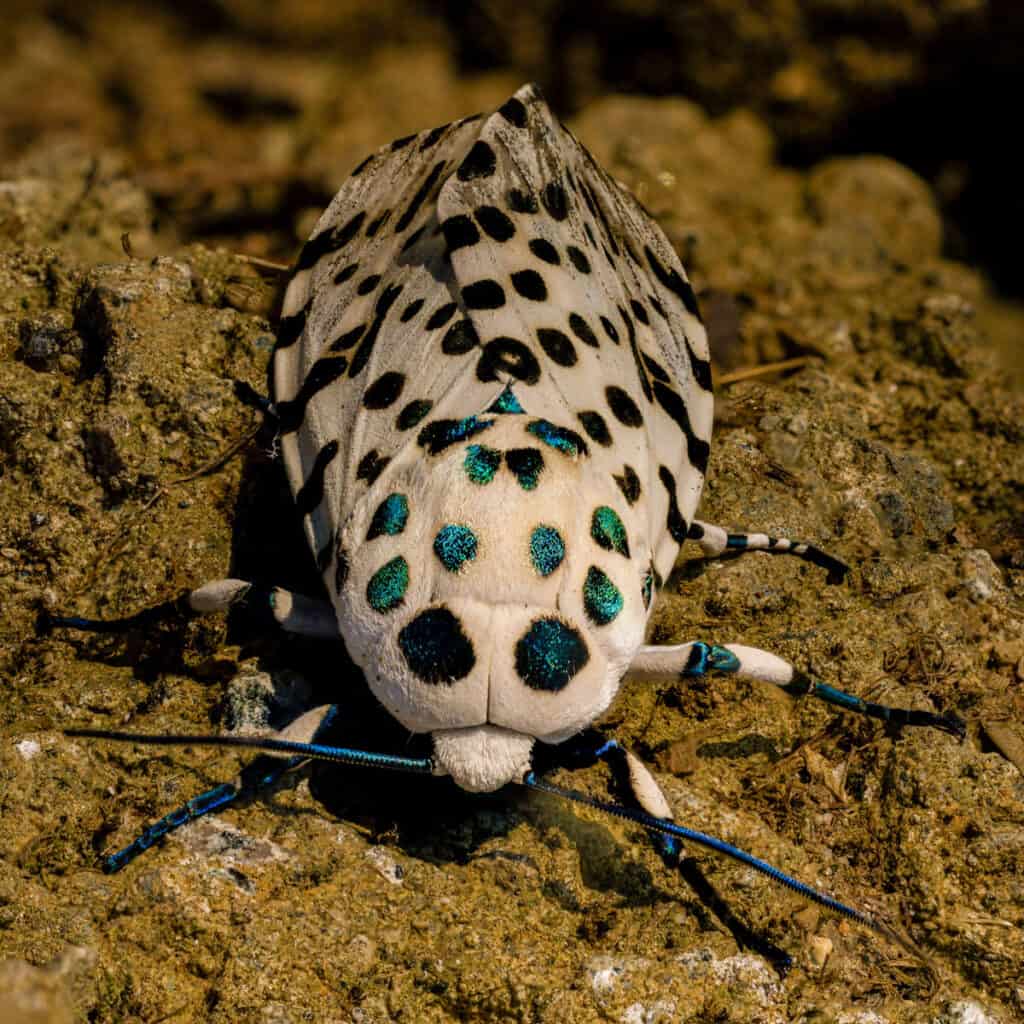
This moth species is undoubtedly one of the most interesting-looking moths in Texas.
©Wirestock Creators/Shutterstock.com
| Feature | Feature |
|---|---|
| Size | Wingspan: 3 inches |
| Appearance | Wings: White with solid and hollow black blotches. Abdomen: Dark blue with orange markings |
| Notable Features | Sexual Dimorphism: Present, with males having a length of 5.1 cm and females 3 cm. |
The giant leopard moth is a striking creature that thrives in North America’s leafy woodlands. You’ll commonly find these moths in Texas, especially in the eastern part of the state. When adults, they happily sip nectar. However, as hungry larvae, they munch on different plants, notably bougainvillea and citrus. Their life starts uniquely — as small, shiny gray eggs. Then, they become fuzzy caterpillars, which closely resemble woolly bears. Finally, after eating for several weeks, they snugly wrap themselves in thin, yellow cocoons. After that exciting journey, they emerge as moths. Interestingly, there’s a size difference; males are generally bigger than females. These moths are most lively from April till September, enjoying the warm days.
3. Black Witch Moth (Ascalapha odorata)
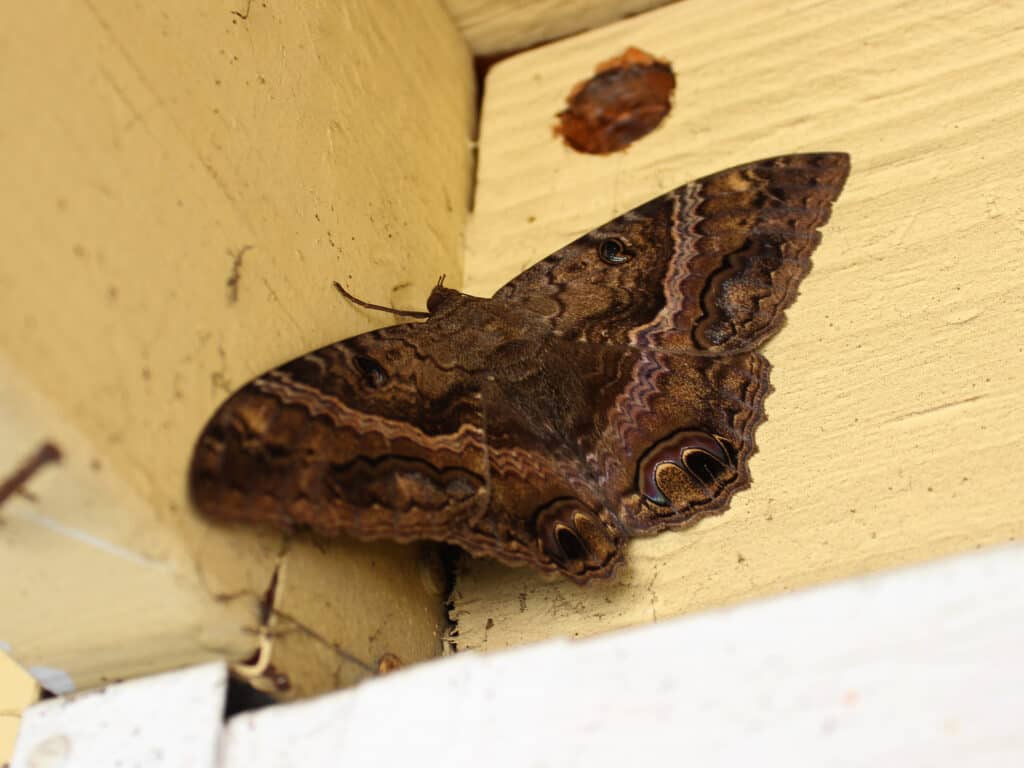
Black witch moths are sometimes called bat moths due to their large size and dark coloring.
©S and S Imaging/Shutterstock.com
| Feature | Description |
|---|---|
| Size | Wingspan: About 6.5 inches in females, slightly smaller in males. |
| Appearance | Mottled brown wings with iridescent pink and purple shades, unique spots on forewings. |
| Notable Features | Sexual Dimorphism: Present, with females larger and paler with white bands on wings. |
The black witch moth is found throughout North America in the US, Mexico, and even parts of Canada. Though it mainly resides in southern regions. This creature thrives in Texas and other warmer regions. These big moths grow to more than 6 inches in width, making them one of the largest in North America.
Black witch moth caterpillars eagerly eat plants, especially legumes and acacia leaves. After munching consistently for the first stage of their lives, they curl up in rough cocoons, preparing to become adults. As moths, they only live for a short 3 to 4 weeks, often feasting on sweet, overripe fruits. They fly very quickly and are seen most between June and October. Interestingly, they have many names, like “butterfly of death.” This name was bestowed on them due to the fact that many people think of them as bad omens. However, in Texas, black witch moths are lucky charms!
4. Isabella Tiger Moth (Pyrrharctia isabella)
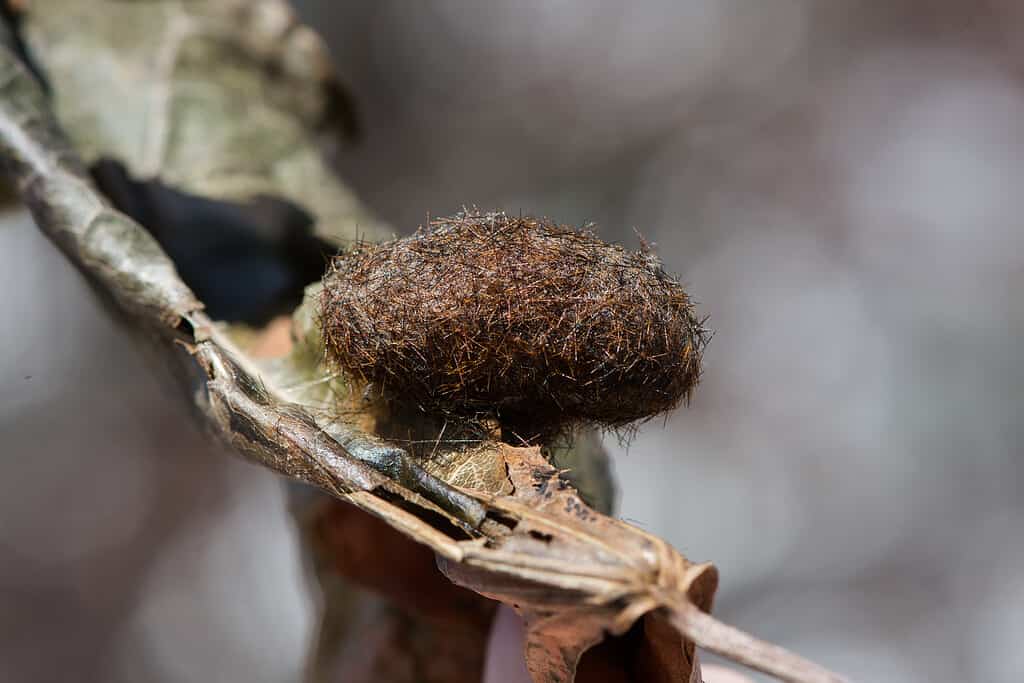
This is the cocoon of the Isabella
tiger
moth.
©Landshark1/Shutterstock.com
| Feature | Description |
|---|---|
| Size | Wingspan: 1.5 to 2 inches. |
| Appearance | Forewings: Tan or yellow with black spots and faint lines. Hindwings: Lighter, color variation between genders. |
| Notable Features | Sexual Dimorphism: Present with females appearing larger and color variation in wings. |
The Isabella tiger moth is native to the US and southern Canada. This species thrives in regions with lots of foliage plants to feed on. The caterpillars of these moths are called woolly bears or woolly worms and spend most of the day feeding on sunflower and maple plants. After this feast, they transform into moths that sip nectar from these same plants. Isabella tiger moths are found throughout central Texas, generally in spring and early summer. These adult moths live briefly, just 1-2 weeks, flying in a fun, spiral, and zigzag pattern from spring to early fall.
5. Io Moth (Automeris io)
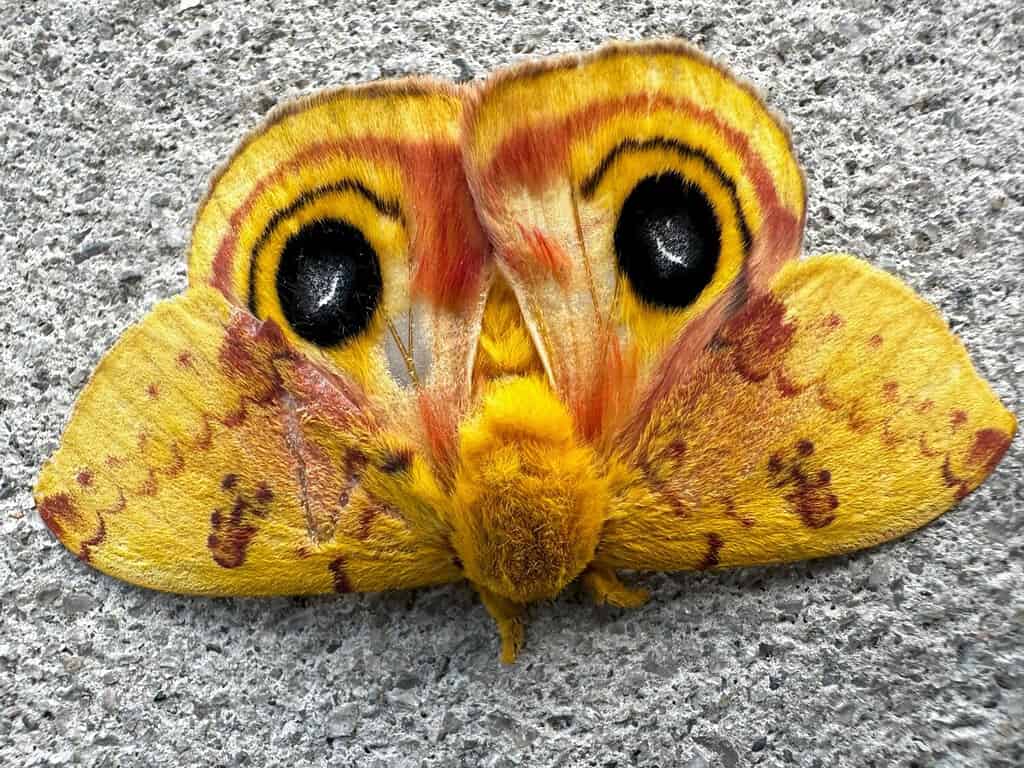
A large, fuzzy moth species, the Io moth is an interesting insect found in Texas.
©Linardo_respado/Shutterstock.com
| Feature | Description |
|---|---|
| Size | Wingspan: 2.5 to 3.5 inches |
| Appearance | Forewings vary in color between genders and regions; hindwings have a prominent eyespot. |
| Notable Features | Sexual Dimorphism, with females being larger; consistent flight pattern. |
You can find the Io moth in many spots of North America, including Texas. This moth species prefers forests, scrublands, and suburbs. The lifecycle of the Io moth starts when female moths lay tiny, pale yellow eggs on plant parts like stems or leaves, which, in roughly 8 to 11 days, become little caterpillars. Though the grown-up moths live for a short 1-2 weeks and don’t eat, they had feasted on trees like Red Maple and Willow earlier as caterpillars. Depending on where they are, their flight time changes — mainly May to June up north, but longer, from February to September, down south.
6. Virginian Tiger Moth (Spilosoma virginica)
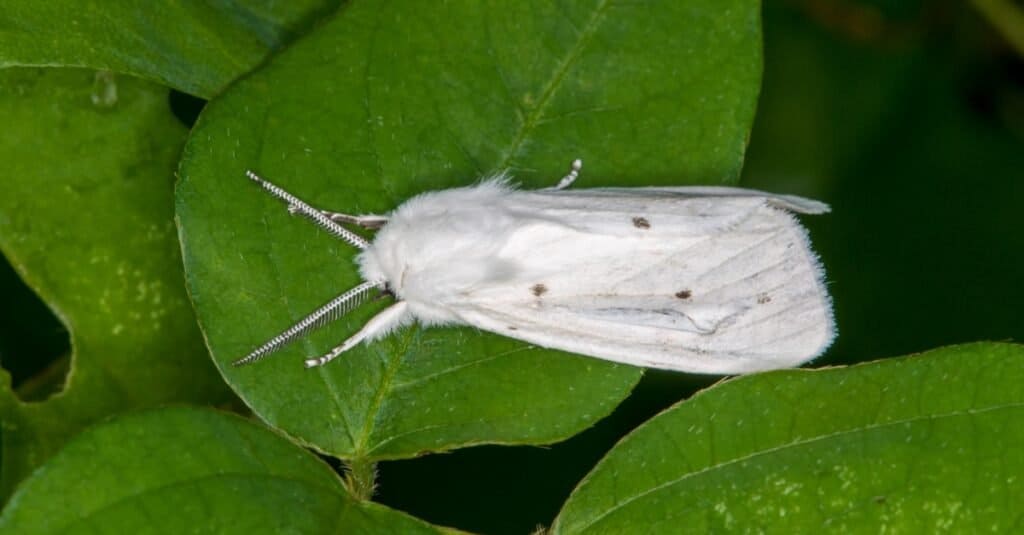
Virginian
tiger moth
caterpillars are also known as yellow wooly bears.
©Michael Siluk/Shutterstock.com
| Feature | Description |
|---|---|
| Size | Wingspan: 1.2 to 2 inches |
| Appearance | White wings with black spots; more spots on hind wings than forewings. |
| Notable Features | Zigzag and erratic flight pattern, mostly in males; active from May — November. |
The Virginian tiger moth is common in many parts of the US, especially Virginia, though you can also find it as far south as Texas! This moth loves wetlands, forests, and grasslands. Their young ones are called yellow woolly bears and eat lots of leaves in their larval state. This can sometimes damage the summer crops as large swaths of Virginian tiger moth caterpillars will chew through entire fields.
Here’s the simple life journey of Virginian tiger moths: It all starts with the mother moth placing batches of eggs on leaves. Then, these turn into furry caterpillars. Later, they snugly wrap up in silky cocoons. After this cozy nap, they wake up as adult moths. Even though these adults live just 1 to 2 weeks, they enjoy sipping nectar from many flowers.
7. Imperial Moth (Eacles imperialis)

The imperial moth can grow to an impressive 6.5 inches!
©IrinaK/Shutterstock.com
| Feature | Description |
|---|---|
| Size | Wingspan: 3 to 6.5 inches |
| Appearance | Yellow wings with brown, purple, and red blotches; variations between genders and regions. |
| Notable Features | Sexual Dimorphism; erratic flight pattern; dwell in both northern and southern regions. |
The imperial moth is a common sight in Texas and lives mainly in both evergreen and deciduous forests. Its life cycle transitions from eggs laying on host plants, sometimes all by themselves or in small clusters. These eggs hatch into large caterpillars that change colors. After their larval state, they turn into reddish-brown pupae, where they will transform into moths. Sadly, adult moths only live for 7 days, with the sole job of reproduction. While the larvae munch on different trees like pine and oak, adult imperial moths don’t eat. Interesting to note — while they’re not endangered, they’re fewer in some places.
8. American Dagger Moth (Acronicta americana)
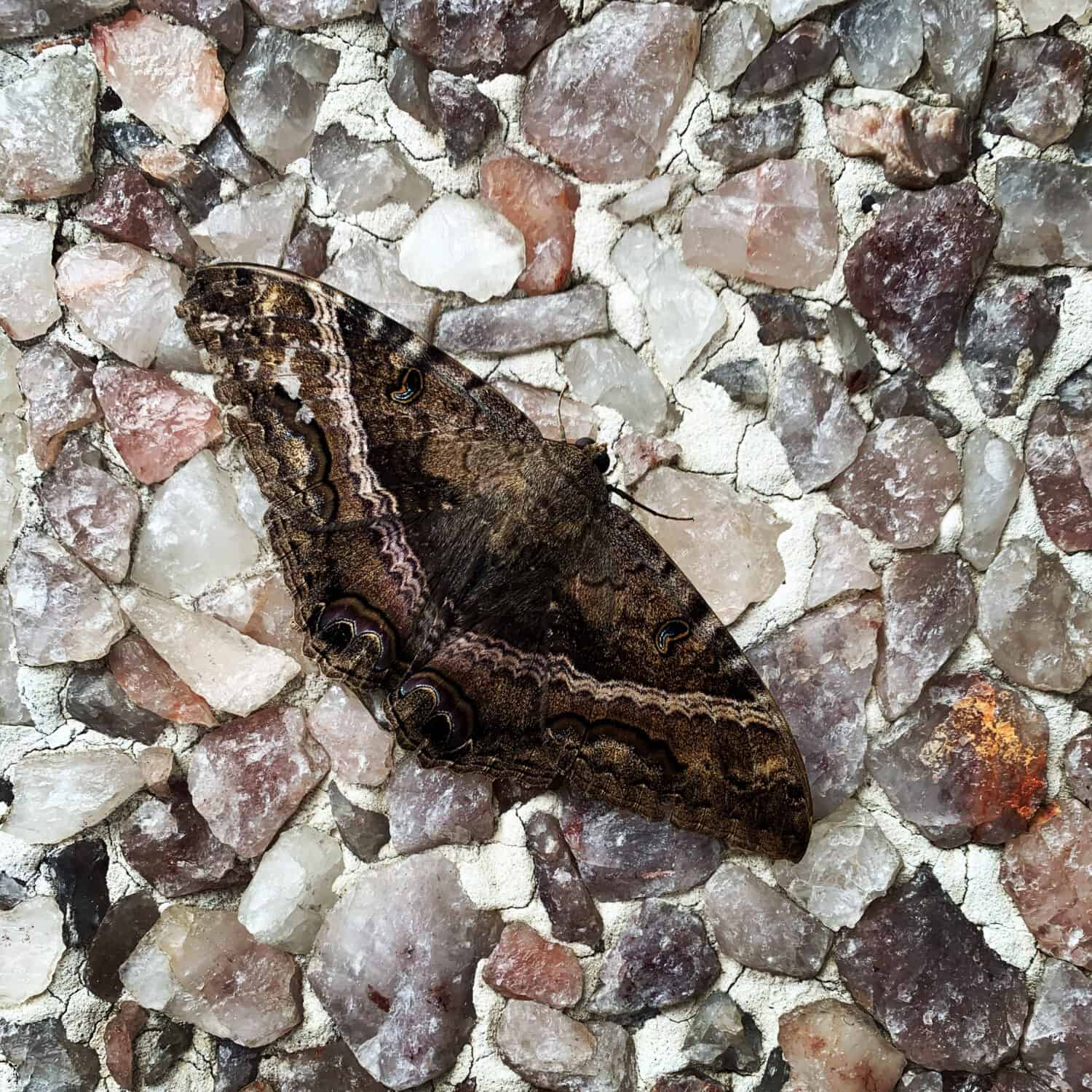
You can find the American dagger moth in Texas.
©ZakStanczyk/Shutterstock.com
| Feature | Description |
|---|---|
| Size | Wingspan: 2 to 3 inches |
| Appearance | Color: Dark grey with black zig-zag lines on forewings, varied patterns like black and white checks, black rings, and a white band on both fore and hind wings. Hind wing’s color differs between sexes. |
| Other Notable Features | Flight Pattern: Erratic, Season: April to September |
You can typically find the American dagger moth in North American forests, especially east of the Rocky Mountains, which includes Texas. This intriguing moth species has a simple life journey, similar to others. Their life begins as small, round eggs that hatch around late spring. As adult moths, they sip nectar, but when they’re caterpillars, they eat from many trees like maple and oak. These adult moths have a short life, just around a week, and exhibit an erratic flight pattern. But be careful! The young American dagger moth caterpillars have prickly hairs that can sting and itch if you touch them. Interestingly, there isn’t just one type of them; three subspecies create diversity within its population.
9. Milkweed Tussock Moth (Euchaetes egle)
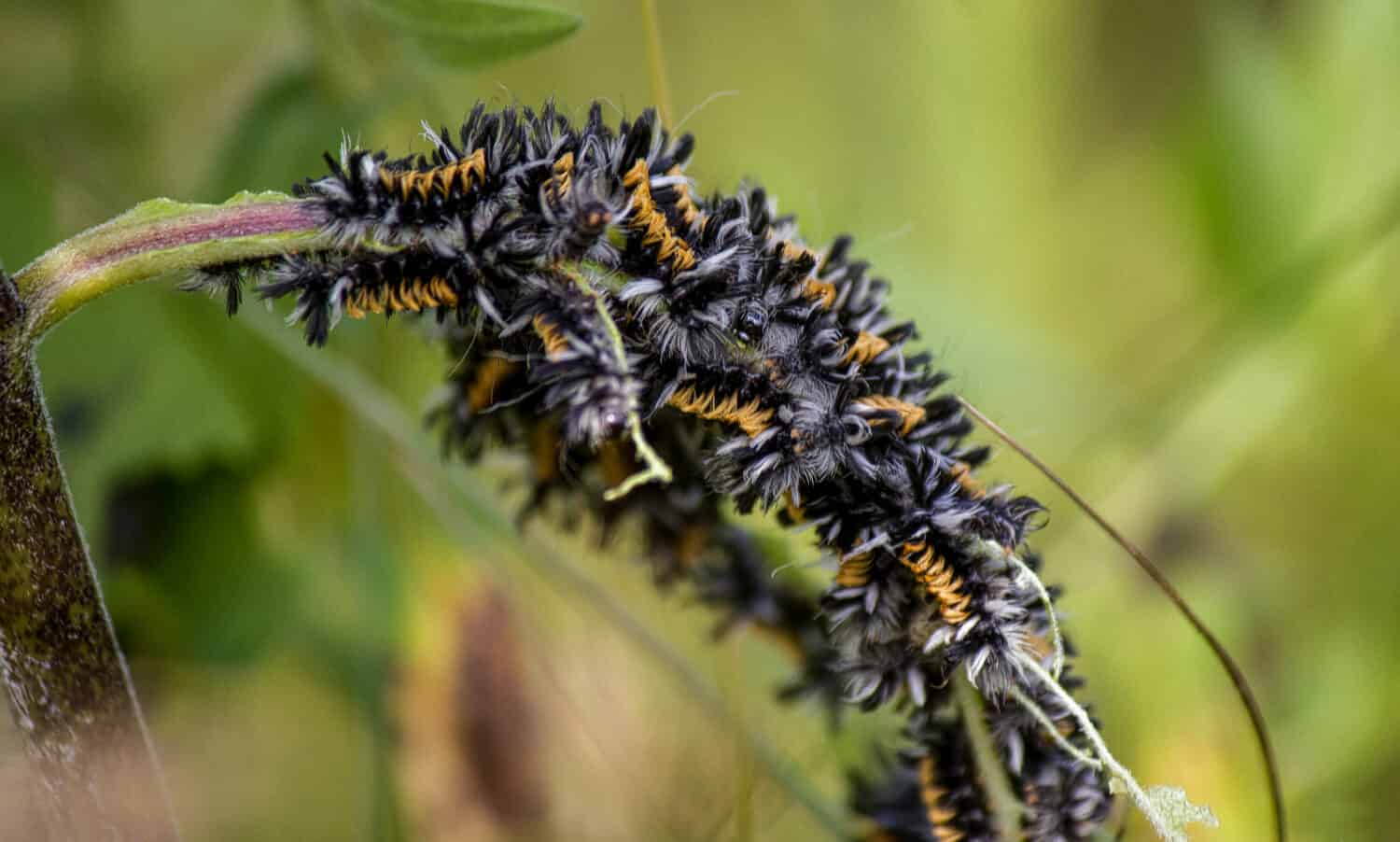
This
caterpillar
feeds exclusively on milkweed and will clear entire swaths of the plant in a few weeks.
©Fiona M. Donnelly/Shutterstock.com
| Feature | Description |
|---|---|
| Size | Wingspan: 1.25 to 1.7 inches |
| Appearance | Dull gray wings, yellow hairy abdomen with black dots arranged in rows on the dorsal region. |
| Notable Features | Erratic flight pattern, active from September to May |
The milkweed tussock moth is a tiny critter, less than 2 inches across! This species thrives in wet places like marshes, where it can feed on its favorite plant, milkweed. Their life cycle initiates with round, light-gray eggs on the underside of milkweed leaves in June. These hatch into tiny caterpillars that change colors throughout their life, from plain gray to bright orange, with black and white stripes. After this colorful stage, the milkweed tussock snugly wraps itself in gray cocoons. When they’re all set, they come out as adult moths that mostly drink nectar. We aren’t sure how long they live, but they’re busy mainly from September to May. Also, they’re an important contribution to the ecosystem by acting as prey for creatures like bats, beetles, and sneaky spiders.
10. Salt Marsh Moth (Estigmene acrea)

This moth species is widespread across North America.
©Jay Ondreicka/Shutterstock.com
| Feature | Details |
|---|---|
| Size | Wingspan: 1.7 to 2.7 inches |
| Appearance | Forewings: White with black spots. Hindwings: Yellowish-orange (males), white (females) |
| Notable Features | They lay 400 to 1000 eggs in clusters. |
The salt marsh moth is an interesting species that lives in open wooded areas, farm fields, meadows, marshes, and prairie grasslands across parts of Texas, Mexico, and other parts of North America. The moth’s life cycle transitions through egg, larval, pupal, and adult stages. The mother lays loads of tiny eggs, about 400 to 1000, that hatch in just five days. These hatchlings munch on many plants — favorites being cabbage, apple, walnut, dandelion, potato, pea, tobacco, maize, and clover. But these tiny caterpillars have predators! Bugs like ladybeetles will try to eat them. As they grow, they transform significantly. They change from eggs to caterpillars and, finally, into full-fledged moths. Interestingly, this species has four subspecies, extending its genetic diversity and adaptability across different regions.
11. Polyphemus Moth (Antheraea polyphemus)
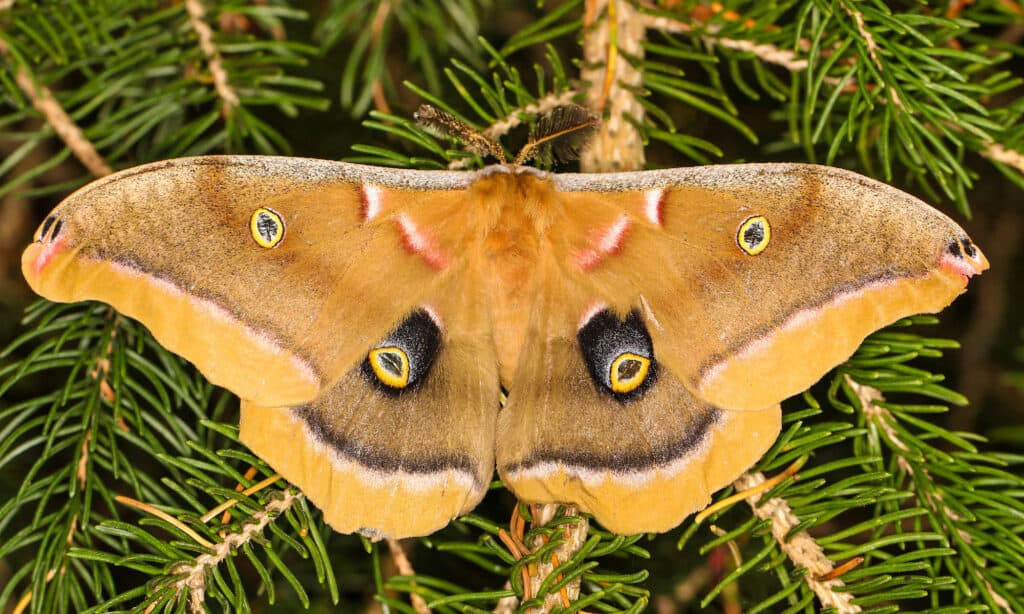
This massive moth can grow to nearly half a foot across!
©iStock.com/BrianLasenby
| Feature | Description |
|---|---|
| Size | Wingspan: 4 to 6 inches |
| Appearance | Forewings: Reddish or yellowish-brown with small transparent oval eyespots. Hindwings have larger eyespots mimicking an eye. |
| Notable Features | Sexual Dimorphism: Differing antennae pattern, males have bushy while females have slender antennae. |
The Polyphemus moth is a fascinating moth in Texas. You can find this species in humid areas and urban environments across southern Canada and the 48 US states. When young, these caterpillars have a HUGE appetite, consuming around 86,000 times their own weight. The life cycle comprises egg, caterpillar, pupa, and adult stages. They munch on many trees, especially apple, ash, birch, elm, hazel, rose, dogwood, hickory, willow, and maple. But adult moths? They don’t eat at all! Unfortunately, Polyphemus moths have several predators that threaten their existence, including yellowjackets, ants, parasitic wasps, raccoons, and squirrels.
12. Banded Tussock Moth (Halysidota tessellaris)

The banded tussock moth is a small creature with a flat body.
©Jay Ondreicka/Shutterstock.com
| Feature | Description |
|---|---|
| Size | Average Wingspan: 1.5 to 2 inches |
| Appearance | Adult Moth: Light brown wings with beige bands, bordered in black. Hairy yellow body with bluish-green lines on their thorax. |
| Notable Features | Not poisonous, but the caterpillar’s prickly hair can cause mild stings. First described by James Edward Smith in 1797. |
The banded tussock moth dwells in meadows, shrublands, and grasslands across North America, extending from southern Canada to central Florida and Texas. As adults, they love sipping flower nectar. But, as little caterpillars, they munch on many trees, their favorites being birch, ash, blueberry, alder, chestnut, hazel, elm, grape, and oak. Their life’s pretty simple: it starts with light green eggs placed in clusters on the lower side of the leaves. These tiny eggs hatch into caterpillars that later wrap up in gray cocoons. After some rest, out come the adult moths. They fly in an interesting and unpredictable way. Watch out, though — the young ones have spiky hairs that might cause mild skin irritation if you touch them.
13. Corn Earworm Moth (Helicoverpa zea)
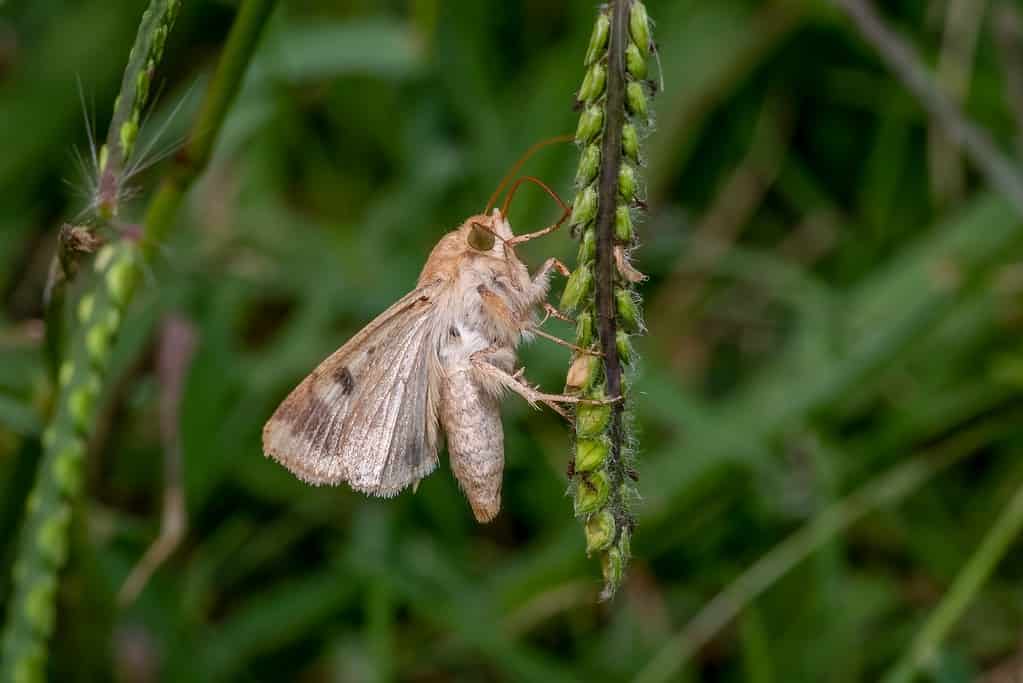
The larva of this species is considered a pest as it infiltrates crops.
©samray/Shutterstock.com
| Feature | Description |
|---|---|
| Size | Average Wingspan: 1.25 to 1.77 inches |
| Appearance | Adult Moth: Yellow-brown forewings with a dark spot at the center; creamy-white and blackish hindwings. |
| Notable Features | Nocturnal |
The corn earworm moth is a wide-ranging insect in North America that you can find in most places outside of the northern reaches of Canada and Alaska. In the caterpillar stage, corn earworm moths are a common pest. They nibble on important crops, including corn and other plants like artichoke, asparagus, and cabbage. As caterpillars, they may even sometimes eat each other! After several weeks in the larval state, they snugly hide 2 to 4 inches deep in the soil, turning into pupae. Once rested, they emerge as an adult. These adult moths live around 5 to 16 days but can extend up to 30 days under optimal conditions, feeding on nectar from plants.
14. Vine Sphinx Moth (Eumorpha vitis)
| Feature | Description |
|---|---|
| Size | Wingspan: 3.5 to 4 inches |
| Appearance | Forewing: Sharp pinkish-white bands and streaks. Hindwing: Pink patch along inner margin, pale whitish brown along outer margin. |
| Notable Features | Three subspecies; Males darker and smaller than females. |
The vine sphinx moth is a moth found in Texas. This species thrives in subtropical lowlands from Argentina, Central America, the West Indies, Mexico, and southern US states. What do they eat? The vine sphinx moth caterpillar eats grape ivy, sweetbay, vine, and willow primrose. After transforming into moths, they exclusively sip nectar, especially from rosy periwinkle and orchids. Their life starts with the female laying eggs near host plants. These eggs then become caterpillars. Vine sphinx caterpillars range from pink, light green, or lemon-yellow in color. After a few weeks as caterpillars, they hide and turn into pupae and transform into adults.
15. Snowberry Clearwing (Hemaris diffinis)
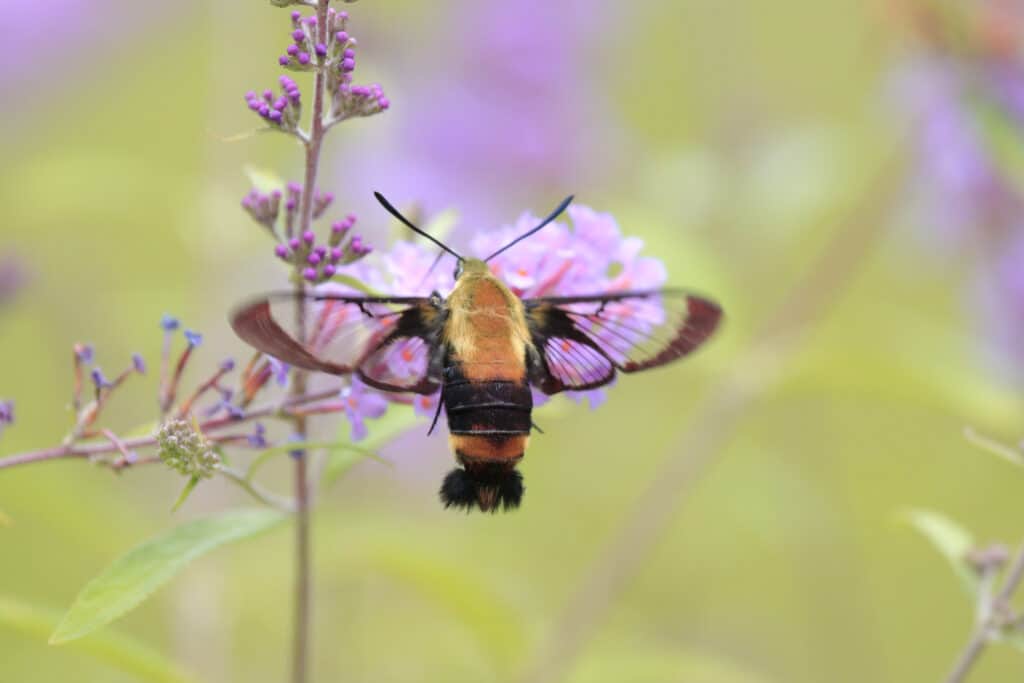
The snowberry clearwing is an interesting moth species that is an excellent pollinator.
©Walter Coate/Shutterstock.com
| Feature | Description |
|---|---|
| Size | Wingspan: 1.25 to 2 inches |
| Appearance | Wings: Clear with reddish-brown terminal borders. |
| Notable Features | Also known as “hummingbird moth” or “flying lobster” in parts of Appalachia. |
The snowberry clearwing moth can be spotted in many northern States and Canada and is a beautiful moth species. While rare, you can also find this moth species as far south as Texas. This moth lives in fields, gardens, open areas, streamsides, and suburbs. As full-grown moths, they sip nectar from flowers, especially Canada violet, dwarf bush honeysuckle, lantana, and others. Their lifecycle starts when females lay eggs near host plants — like cherry, dogbane, plum, and snowberry. As they grow, the little caterpillars are green with tiny black spots. They turn into pupae in leafy cocoons and, later, become adult moths.
Summary of the 15 Most Common Moths You’ll Find in Texas
| Moth Name | Scientific Name |
|---|---|
| Hummingbird Clearwing | Hemaris thysbe |
| Giant Leopard Moth | Hypercompe scribonia |
| Black Witch Moth | Ascalapha odorata |
| Isabella Tiger Moth | Pyrrharctia isabella |
| Io Moth | Automeris io |
| Virginian Tiger Moth | Spilosoma virginica |
| Imperial Moth | Eacles imperialis |
| American Dagger | Acronicta americana |
| Milkweed Tussock Moth | Euchaetes egle |
| Salt Marsh Moth | Estigmene acrea |
| Polyphemus Moth | Antheraea polyphemus |
| Banded Tussock Moth | Halysidota tessellaris |
| Corn Earworm Moth | Helicoverpa zea |
| Vine Sphinx Moth | Eumorpha vitis |
| Snowberry Clearwing | Hemaris diffinis |
The photo featured at the top of this post is © Jay Ondreicka/Shutterstock.com
Thank you for reading! Have some feedback for us? Contact the AZ Animals editorial team.




